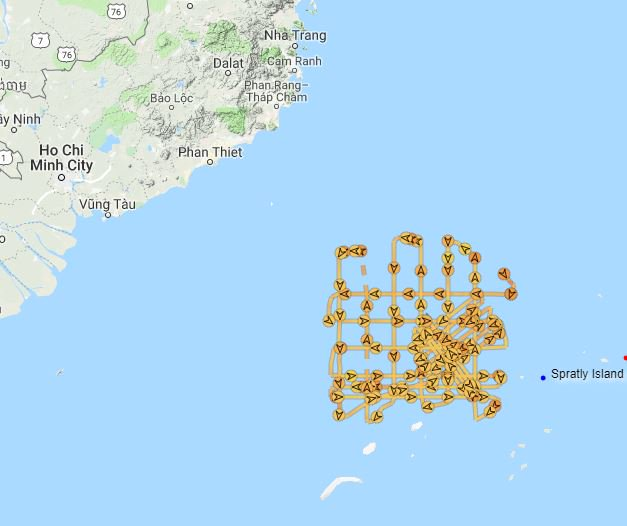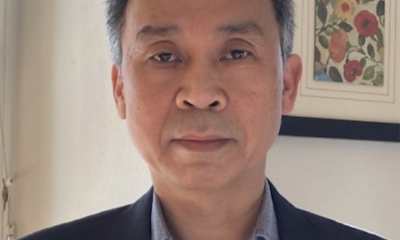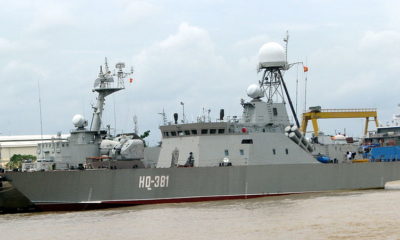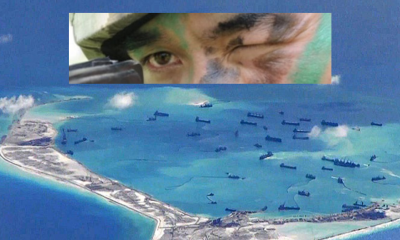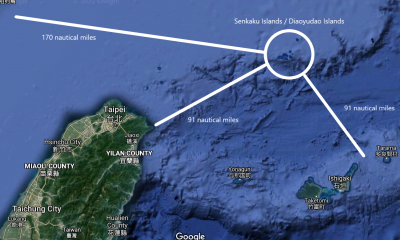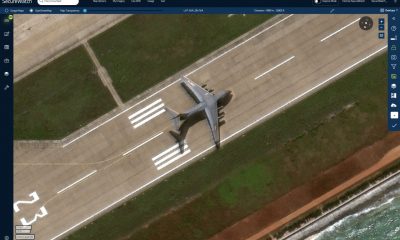Nguyen Luong Hai Khoi
China’s Campaign to intrude into the Continental Shelves and EEZs of Southeast Asian Countries in 2019 (Part 1: Process of the campaign, Part 2: Military tactics of the campaign, Part 3: Legal Aspects of the campaign)
Research Conducted by HYDZ-8
The exclusive economic zone (EEZ) is an area extending 200 nautical miles from the baseline. The EEZ is an area where a coastal country has full economic rights, but other countries have the right to travel and conduct scientific research. Survey vessel HYDZ-8 and other Chinese ships have the right to move in Vietnam’s EEZ. However, the HYDZ-8 concentrated in two regions for three months. This activity was not an innocent passage but rather in-depth research and investigation in Malaysia and Vietnam’s continental shelves and EEZs.
We do not know whether the operation of the HYDZ-8 survey vessel is related to the exploitation of natural resources or not. However, by comparing the HYDZ-8 survey vessel’s operation map with Vietnam’s diagram of the oil and gas production blocks, we realized that HYDZ-8 concentrated operations in two regions where Vietnam has been exploring and exploiting oil and gas for decades.
As seen below, AMTI compiled HYDZ-8’s movement from July to October 2019 based on Marine Traffic data and compared it with Chinese oil and gas blocks in Vietnam’s continental shelf. In this AMTI map, blue zones are oil and gas blocks that China drew within Vietnam’s exclusive economic zone and continental shelf. The red lines are the paths HYDZ-8 took from July to October 2019.
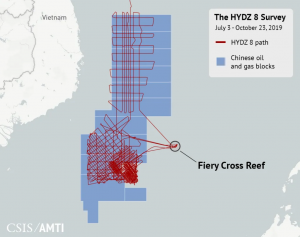
Below we combine the paths of HYDZ-8 and four basins where Vietnam has explored and exploited oil and gas for many decades including Phu Khanh Basin, Cuu Long Basin, South Con Son Basin, and Vanguard (Vietnamese: Tu Chinh) Basin.
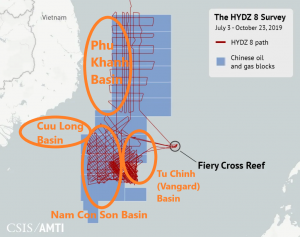
(Original map is designed by AMIT. The author added locations of four basins)
In the map below we compare the survey paths of HYDZ-8 with Vietnam’s oil and gas blocks off central Vietnam in Phu Khanh Basin.
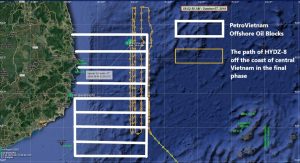
HYDZ-8 surveyed Vietnam’s oil exploration and exploitation area offshore of central Vietnam.
Under UNCLOS, “marine scientific research in the exclusive economic zone and on the continental shelf shall be conducted with the consent of the coastal State.” (See: Article 246, UNCLOS). Vietnam has never approved China to survey in an area less than 200 nautical miles from Vietnam’s baseline, let alone the less than 90 nautical miles where China surveyed from July to October 2019. Also, under Article 246, UNCLOS, “coastal states may however in their discretion withhold their consent to the conduct of a marine scientific research project of another State or competent international organization in the exclusive economic zone or on the continental shelf of the coastal State if that project:
(a) is of direct significance for the exploration and exploitation of natural resources, whether living or non-living;
(b) involves drilling into the continental shelf, the use of explosives or the introduction of harmful substances into the marine environment;”
In the campaign to intrude into and survey Vietnam’s continental shelf, China also sent ships to block and harass Vietnam’s Hakuryu-5 rig, which was exploring in the Nam Con Son Basin (“Wanan Basin” in Chinese) near Vanguard Bank. This behavior violated UNCLOS and the Charter of the United Nations. UNCLOS requires that “States Parties shall settle any dispute between them concerning the interpretation or application of this Convention by peaceful means in accordance with Article 2, paragraph 3, of the Charter of the United Nations and, to this end, shall seek a solution by the means in Article 33, paragraph 1, of the Charter.” (Article 279) The Charter of the United Nations states that “all members shall settle their international names by peaceful means in such a manner that international peace and security, and justice, are not endangered,” (Article 2, paragraph 3) and, “the parties to any dispute, the continuance of which is likely to endanger the maintenance of international peace and security, shall, first of all, seek a solution by negotiation, inquiry, mediation, conciliation, arbitration, judicial settlement, resort to regional agencies or arrangements, or other peaceful means of their own choice.” (Article 33, paragraph 1)
China’s intrusion campaign mobilized armed forces with heavy weapons and harassed Vietnam and Malaysia’s oil and gas rigs. China has violated UNCLOS and the Charter of the United Nations.
China’s “New Tactic”
In a regular press conference on August 19, 2019, China’s Foreign Ministry Spokesperson Geng Shuang claimed that sovereignty over the Spratly Islands is the legal basis that allows China to survey Vietnam’s continental shelf and exclusive economic zone.
China has sovereignty over the Nansha Islands and its adjacent waters and has sovereign rights and jurisdiction over the relevant waters. The relevant Chinese ship was all along operating in waters under China’s jurisdiction. During that process, the ship properly adjusted its operation plan in accordance with the maritime conditions and practical needs. We hope the relevant country will earnestly respect China’s sovereign rights and jurisdiction and work with China to uphold harmony and tranquility in those waters.
On September 18, 2019, China repeated the above position:
China has sovereignty over Nansha Islands and sovereign rights and jurisdiction over adjacent waters of Wan’an Tan (Vanguard Bank) in the Nansha Islands. That is solidly grounded in history and law. (Note: Wan’an Tan is Vanguard Bank. Vietnamese name: Tu Chinh Bank)
By claiming that Vanguard Bank (Chinese: Wan’an Tan) is part of the Spratlys, China attempted to rationalize its behaviors inside Vietnam’s continental shelf and exclusive economic zone based on Vietnam’s inland baseline. However, Vanguard Bank is not a part of the disputed Spratly Islands. It is 170 nautical miles off the coast of Vietnam. At 300 nautical miles away, it is far from Itu Aba Island, the most extensive geographical feature in the Spratly Islands. Under the 2016 PCA ruling, all geographic features in the Spratly Islands have no island effects, “none of the high-tide features in the Spratly Islands are capable of sustaining human habitation or an economic life of their own,” therefore, “do not generate entitlements to an exclusive economic zone or continental shelf.” (PCA tribunal, Paragraph 646)
Therefore, no matter which country possesses the Spratly Islands, sovereignty over the Spratly Islands is not related to sovereignty over “its adjacent waters,” including Vanguard Bank, a sea area inside Vietnam’s exclusive economic zone and continental shelf.
This statement shows that China wants to avoid mentioning the U-shaped line while still claiming everything inside the South China Sea. Besides, China wants to turn areas that do not relate to the Spratly Islands into disputed zones, thereby seeking reasons to intrude, suppress, and gain sovereignty.
Interestingly, Vietnam has foreseen and criticized this “new tactic” of China since 2013. Vanguard Bank is a basin under the sea, 170 nautical miles from mainland Vietnam. Its highest point is 52.5 feet (16 meters) above sea level. In 2013, Vietnam stated that Vietnam did not intentionally turn Vanguard Bank into any artificial islands and deliberately ascribed it to become a part of the Spratly Islands. “Vietnam considers that all such intentionally building any artificial islands and deliberate ascription are completely wrong in the interpretation and compliance with the 1982 United Nations Convention on the Law of the Sea, which must be condemned and rejected.” (The Central Propaganda Department of the Central Committee of the Communist Party of Vietnam, “100 questions and answers about the sea and islands for Vietnamese youth“, Hanoi: Information and Communication Publishing House, 2013, pp. 141–43.)
Related article
China’s Campaign to intrude into the Continental Shelf and EEZs of Southeast Asian Countries in 2019 (Part 1: Process of the campaign, Part 2: Military tactics of the campaign, Part 3: Legal Aspects of the campaign)

 Politics & Economy3 years ago
Politics & Economy3 years ago
 Society & Culture4 years ago
Society & Culture4 years ago
 ARCHIVES4 years ago
ARCHIVES4 years ago
 Politics & Economy3 years ago
Politics & Economy3 years ago
 Politics & Economy4 years ago
Politics & Economy4 years ago
 Politics & Economy3 years ago
Politics & Economy3 years ago
 Politics & Economy4 years ago
Politics & Economy4 years ago
 ARCHIVES3 years ago
ARCHIVES3 years ago
